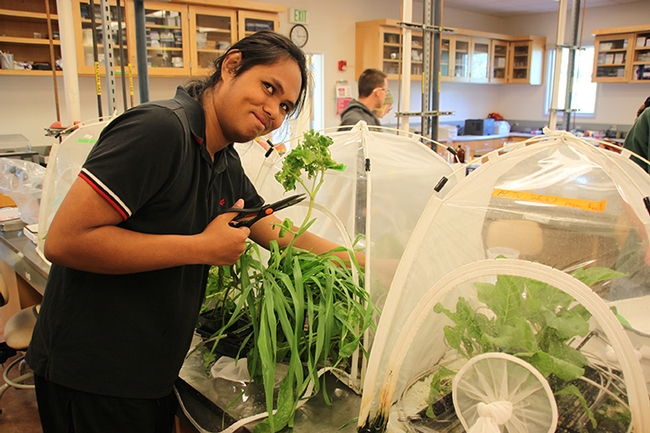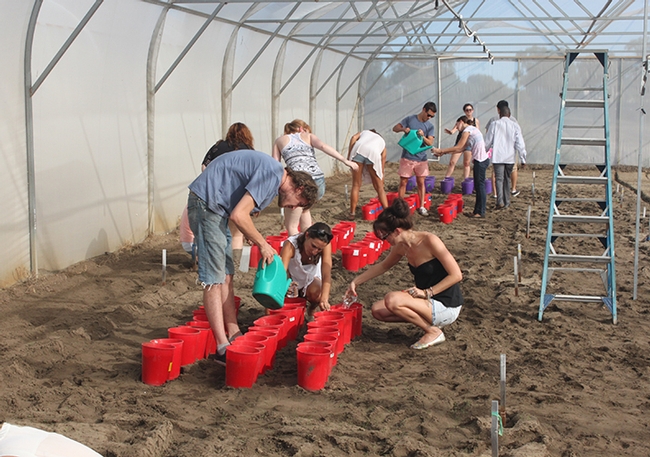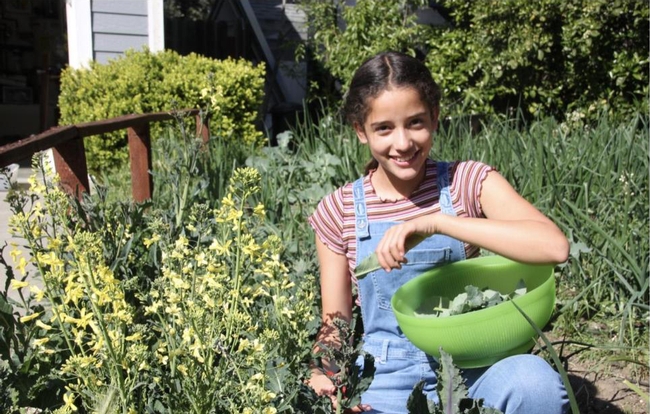- Author: Kathy Keatley Garvey

In a newly published article on “The School of Food” in Futurum, Nansen advocates that all school curricula be “rooted in a single dominator: food.”
Biology, ecology and environmental science should be “taught based on subjects related to the growth of plants and animals,” Nansen writes. Literature, history, sociology and humanities should focus on “the importance of food concepts, like ‘breaking bread,' feasts and banquets.”
“What I am proposing here is already being done, in part, as individual initiatives and projects,” he writes. “For example, many schools have a butterfly garden, biology labs keep colonies of insects, students grow some vegetables and have a few livestock animals. In some schools, students learn how to eat and cook healthy food.”
Futurum is a website geared toward students and teachers to become inspired and interested in science. It focuses on research, analysis and insights.
Nansen, whose research interests include insect ecology, integrated pest management, and remote sensing, says that such a focus on food “would strengthen, not weaken, the academic rigor that could be delivered to students of all age groups.”
“That is, ‘food' as an educational denominator can be taught and approached with multiple goals in mind, and these would be similar to the current distinctions between practical and more theoretical classes. By engaging with students through the prism of food, we can make math, physics, history, biology, literature--all these topics more relevant to students and make the teaching more interactive and challenge-based.”
Nansen acknowledges that it is crucial that schools teach students about traditional subjects and provide them with essential skill sets regarding problem solving, critical thinking and basic knowledge, but that that students “can all be taught very effectively through an underlying emphasis on food.”
For example, he mentions that students of all ages can grow crop plants in small pots inside a classroom or outside (small plots and roof gardens), “and study growth as a function of time and growing conditions.” More advanced practical tasks could include developing irrigation systems, and plant and animal breeding programs.
Another example: for engineering, computer sciences and food production, students could delve into solar panels, rainwater catchment systems and water recycling methods. At the more advanced level, they could integrate robotics and machine learning system.
Nansen, linking chemistry with cooking, comments: “Cooking is nothing more and nothing less than applied chemistry. How does the pickling of vegetables work? What is happening when cream is whipped? What happens to food during heating and/or frying? Salting olives, fish and other types of meat has been practiced for thousands of years—how does this means of preserving food actually work?”
In his article, Nansen also explains how food can be incorporated in such subjects as humanities, human history, social studies and math.
Eating has changed over time, the professor acknowledges, “and it varies among countries and cultures, meaning that not all students view food in the same way.” But teachers can capitalize on diversity in the classroom, he relates. They can also address “societal challenges, such as obesity” and elevate levels of empowerment related to stresses, such as fear.
In the article, Nansen shared a project he assigned to his 11-year daughter, Molly, during the sheltering-in requirements: “How much cabbage would be needed to meet the Vitamin K requirements for her entire class for a whole year?”
In addition to learning about the metric system, using Excel spread sheets, regression analyses and calculus, Molly investigated websites and came to several conclusions:
- A person can harvest about 3 kg per m2 (kilograms per square meter)
- A student her age has to have 105 grams of cabbage to meet daily vitamin K requirements
In addition, she created a cabbage-muffin recipe and calculated she would need to eat four muffins per day to meet the daily Vitamin K requirements. She also calculated she would need 2,291 m2 to grow enough cabbage to meet the daily vitamin K requirement for her entire school. It is age-dependent, so that was a bit tricky to figure out.
And lastly, using Google Earth, Molly suggested where to place the cabbage field next to her school. (Her entire project is online as a sidebar.)
Virtual Youth Summit on Food and Education 2021
Nansen said he seeks contact with teachers and headmasters "interested in pursuing this approach at some level at their school."
"The idea is now to take this several steps further, through collaboration with teachers and their students, and set up a web-based platform to host an annual virtual youth summit on food and education!" he said. "That is, groups of students, in collaboration with their teachers and as part of course curricula, produce a 3-5 minute video describing a particular project they have executed. These videos would then be shown at the virtual youth summit, and we will organize review panels of students, teachers, and scientists to comment on the videos. These video projects would be divided into age groups and topics – still to be determined."
"I am hoping that we will be able to create a very special category of video projects describing two schools (have to be on separate continents) doing a project together," Nansen said. "As a start, we are pursuing the potential of a school in California working with a school in Uganda… which would be awesome!"
"We may be able to obtain corporate sponsorships and therefore be able to offer prizes/awards to participating schools, teachers and student groups. With corporate sponsorships, we may also be able to offer logistical support to schools – computers, software licenses (to create videos), basic lab supplies and equipment to conduct experiments.'"
"Just imagine a school being able to put on its website that a group of students competed in the Virtual Youth Summit on Food and Education 2021 and was selected as one of the winners! Students can put this experience on their resume when they later apply to university or jobs. Teachers can include this in their evaluation dossiers."
"Initially, we need to identify teachers interested in joining this effort--ideally teachers from multiple countries," Nansen related. "Once we have 5-10 teachers committed, then we can start putting together the virtual platform and invite schools and teachers more broadly." School teachers and others potentially interested in getting involved can contact him at chrnansen@ucdavis.edu.







